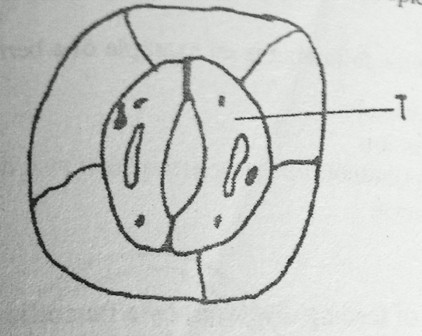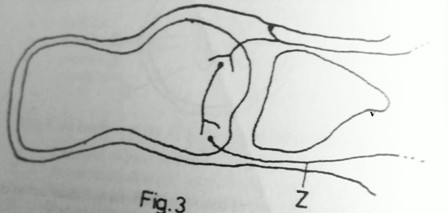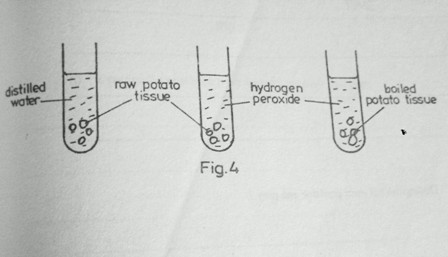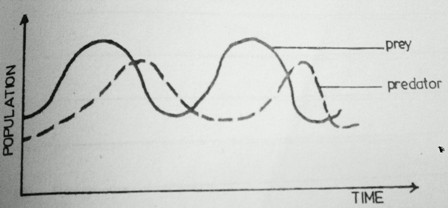PAPER 1
THEORY
SECTION A
Answer all questions in this section. For each question select the most correct option and write the letter representing it in the box provided.
1. Figure 1 below shows the structure of a part of the lower epidermis of a leaf.

What is the structure labelled T?
A. Stoma
B. Vacuole
C. Chloroplast
D. Guard cell
2. Which of the following blood vessels transports blood most rich in nutrients?
A. Pulmonary artery.
B. Hepatic portal vein.
C. Mesenteric artery.
D. Renal vein
3. Which one of the following is an example of biological control of pests?
A. Application of pesticides.
B. Destruction of pests' habitats.
C. Interruption of pests' breeding cycle.
D. Introduction of pests' predators.
4. The effect of unidirectional light on the distribution of auxin in the tip of a plant shoot is
A. Uniform distribution of auxin around the tip.
B. Reduction in concentration of auxin on the illuminated side of the plant.
C. Increase in auxin on the illuminated side of the plant.
D. Inhibition of movement of auxin down the plant.
5. Which of the following is a function of thyroxin hormone?
A. Promotes development of follicle in the ovary.
B. Prepares the body for fright - flight action.
C. Controls body metabolic rate.
D. Regulates sugar content of the body.
6. Which of the following is an example of a berry?
A. Avocado
B. Passion
C. Groundnut
D. Cotton
7. The mode of feeding displayed by a Mucor is described as
A. Holozoic
B. Filter feeding
C. Parasitic
D. Saprophytic
8. What is function of the Eustachian tube in the human ear?
A. Detection of body posture
B. Transmission of sound waves to the middle ear.
C. Equalizing pressure in the middle ear.
D. Transmission of sound waves to the inner ear.
9. If a man of blood A is married to a woman of blood group O, what are the possible genotypes of their children?
A. AA, OO
B. AA, AO
C. AO, OO
D. AO only
10. What relationship exists between a groundnut plant and nitrogen fixing bacteria in its root nodules?
A. Parasitism
B. Saprophytism
C. Naturalism
D. Symbiosis
11. Which type of soil has the following characteristics?
(i) Heavy to cultivate.
(ii) Rich in dissolved minerals
(iii) High capillarity
A. Loam
B. Clay
C. Sand
D. Silt loam
12. In figure 2 below, which part transports water and dissolved minerals?
13. Which of the following features belong to both an arachnidan and an insect?
A. Cuticle and two pairs of wings.
B. Six legs and two pairs of wings.
C. Six legs and antennae.
D. Jointed legs and cuticle.
14. Which one of the following statements best explains why urine does not normally contain glucose?
A. Glucose molecules are too large to pass through the capillaries of the glomerular.
B. Glucose present in the renal tubule is changed to carbon dioxide and water.
C. All the glucose filtered is re-absorbed back into the blood in the renal tubules.
D. The bladder re-absorbs all the glucose filtered.
15. Aerobic respiration is more efficient than anaerobic respiration because it
A. Uses more oxygen.
B. Yields lactic acid.
C. Uses less oxygen.
D. Yields more energy.
16. In humans, the hormone progesterone stimulates the
A. Formation of egg cells.
B. Formation of sperm cells.
C. Production of milk by a lactating mother.
D. Thickening of the uterine wall.
17. What is the destination of the impulses moving along the nerve fibre marked Z in figure 3 below?

A. The spinal cord
B. The brain
C. The effectors organ
D. The receptor organ
18. Which of the diseases listed below is a result of lack of the Anti-Diuretic Hormone (ADH) in the body?
A. Diabetes mellitus
B. Anaemia
C. Goiter
D. Diabetes inspidus
19. The following are body responses to change in temperature of a mammal:
(i) Shivering
(ii) Increased blood supply to the skin.
(iii) Decreased of erector Pilli muscle.
Which two of these are responses to a fall in body temperature?
A. (i) and (ii)
B. (ii) and (iii)
C. (iii) and (iv)
D. (i) and (iii)
20. Which one of the following pairs of bones forms a ball and socket joint?
A. Humerus and ulna.
B. Femur and pelvis
C. Humerus and radius
D. Femur and tibia
21. Which of the following characteristics show discontinuous variation?
A. Body weight
B. Blood groups
C. Size of leaves
D. Color of flowers
22. What one of the following responses is a directional growth movement?
A. Taxis
B. Reflex
C. Tropic
D. Nastic
23. The blood serum of universal donor contains
A. Antigens A
B. Antigens B
C. Neither antigens A nor B
D. Both antigens A and B
24. Meiosis leads to the production of
A. Two daughter cells each with original number of chromosomes.
B. Four daughter cells each with original number of chromosomes.
C. Two daughter cells each with half the original number of chromosomes
D. Four daughter cells each with half the original number of chromosomes.
25. Which one of the following organisms carries out intracellular digestion?
A. Fungi
B. Algae
C. Amoeba
D. Hookworm
26. If energy from the sun was cut off from an ecosystem containing the following organisms.
(i) Green plants.
(ii) Herbivores.
(iii) Saprophytes.
(iv) Carnivores.
In which order would the organizations die out?
A. (i), (ii), (iii) and (iv)
B. (i), (ii), (iv) and (iii)
C. (iii), (i), (ii) and (iv)
D. (i), (iii), (ii) and (iv)
27. A plant with poorly developed roots is likely to be growing in a soil that is deficient in
A. Sulphur.
B. Phosphorus.
C. Magnesium.
D. Iron.
28. In fish, the fins which are used in propulsion movements are
A. Caudal
B. Dorsal
C. Pelvic
D. Ventral
29. Phagocytosis is the process whereby white blood cells
A. Ingest bacteria.
B. Cause the bacteria to stick together.
C. Dissolve the outer coats of invading bacteria.
D. Neutralize bacteria.
30. The following are factors that affect the rate of transpiration:
(i) High temperature.
(ii) High relative humidity.
(iii) Low atmospheric pressure.
(iv) Low light intensity
Which two of these would favour increased transpiration?
A. (i) and (ii)
B. (i) and (iii)
C. (ii) and (iv)
D. (iii) and (iv)
SECTION B
Answer all questions in this section. Answers must be written in the spaces provided.
31. a) What is an enzyme?
b) Study the experimental set up in figure 4 below and answer the questions that follow:

(i) What is being investigated?
(ii) Suggest what was observed in each of the test tubes.
(iii) Explain the observations suggested in (b) (ii) above.
32. a) Distinguish between predator and prey?
b) Figure 5 below shows predator/ prey relationship. Study the figure and answer the questions that follow:

(i) Describe the relationship between the predator and prey.
(ii) Explain the relationship of the predator and prey described in (b) (i) above.
(iii) Name two other external factors that may affect the population of the prey in the habitat.
33. a) What is soil erosion?
b) Name four types of soil erosion.
c) State the causes of soil erosion.
d) How does mulching help the farmer in
(i) Water conservation?
(ii) Soil conservation?
34. a) (i) State the difference between cross pollination and self pollination.
(ii) Give three structural features of flowers that ensure cross pollination.
b) Give five adaptations of flowers for insect pollination.
SECTION C
Answer any two questions
35. Describe an experiment to show that oxygen is produced during photosynthesis.
36. a) Give three secondary sexual characteristics in a human female.
b) Describe the main events that occur during the menstrual cycle in a mammal.
37. a) Describe the life cycle of a housefly.
b) What is the economic importance of a housefly?
c) How would you minimize the spread of housefly?
38. a) Define:
(i) Phototropism.
(ii) Geotropism.
b) Describe an experiment you would carry out to determine the effects of gravity on the root of a dicotyledonous plant.
